OPTICAL ISOMERISM:
Optical isomerism is a form of stereoisomerism. This page explains what stereoisomers are and how you recognise the possibility of optical isomers in a molecule.
What are isomers?
Isomers are molecules that have the same molecular formula, but have a different arrangement of the atoms in space. That excludes any different arrangements which are simply due to the molecule rotating as a whole, or rotating about particular bonds.
Where the atoms making up the various isomers are joined up in a different order, this is known as structural isomerism. Structural isomerism is not a form of stereoisomerism.
What are Stereoisomers?
In stereoisomerism, the atoms making up the isomers are joined up in the same order, but still manage to have a different spatial arrangement. Optical isomerism is one form of stereoisomerism.
Optical Isomerism:
Why optical isomers?
Optical isomers are named like this because of their effect on plane polarised light.
Simple substances which show optical isomerism exist as two isomers known as enantiomers.
- A solution of one enantiomer rotates the plane of polarisation in a clockwise direction. This enantiomer is known as the (+) form.For example, one of the optical isomers (enantiomers) of the amino acid alanine is known as (+)alanine.
- A solution of the other enantiomer rotates the plane of polarisation in an anti-clockwise direction. This enantiomer is known as the (-) form. So the other enantiomer of alanine is known as or (-)alanine.
- If the solutions are equally concentrated the amount of rotation caused by the two isomers is exactly the same – but in opposite directions.
- When optically active substances are made in the lab, they often occur as a 50/50 mixture of the two enantiomers. This is known as a racemic mixture or racemate. It has no effect on plane polarised light
How Optical Isomers Arise?
The examples of organic optical isomers required at A’ level all contain a carbon atom joined to four different groups. These two models each have the same groups joined to the central carbon atom, but still manage to be different:
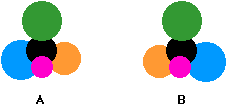
Obviously as they are drawn, the orange and blue groups aren’t aligned the same way. Could you get them to align by rotating one of the molecules? The next diagram shows what happens if you rotate molecule B.
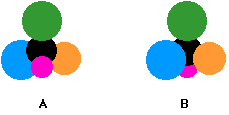
They still aren’t the same – and there is no way that you can rotate them so that they look exactly the same. These are isomers of each other.
They are described as being non-superimposable in the sense that (if you imagine molecule B being turned into a ghostly version of itself) you couldn’t slide one molecule exactly over the other one. Something would always be pointing in the wrong direction
What happens if two of the groups attached to the central carbon atom are the same? The next diagram shows this possibility.
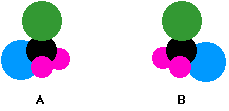
The two models are aligned exactly as before, but the orange group has been replaced by another pink one.
Rotating molecule B this time shows that it is exactly the same as molecule A. You only get optical isomers if all four groups attached to the central carbon are different.
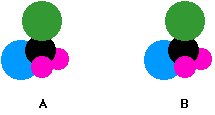
Chiral and Achiral Molecules:
The essential difference between the two examples we’ve looked at lies in the symmetry of the molecules.
If there are two groups the same attached to the central carbon atom, the molecule has a plane of symmetry. If you imagine slicing through the molecule, the left-hand side is an exact reflection of the right-hand side.
Where there are four groups attached, there is no symmetry anywhere in the molecule.
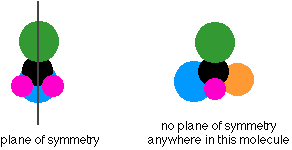
A molecule which has no plane of symmetry is described as chiral. The carbon atom with the four different groups attached which causes this lack of symmetry is described as a chiral centre or as an asymmetric carbon atom.
The molecule on the left above (with a plane of symmetry) is described as achiral.
Only chiral molecules have optical isomers.
The Relationship Between the Enantiomers:
One of the enantiomers is simply a non-superimposable mirror image of the other one.
In other words, if one isomer looked in a mirror, what it would see is the other one. The two isomers (the original one and its mirror image) have a different spatial arrangement, and so can’t be superimposed on each other.
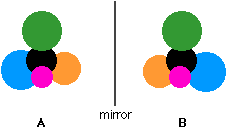
If an achiral molecule (one with a plane of symmetry) looked in a mirror, you would always find that by rotating the image in space, you could make the two look identical. It would be possible to superimpose the original molecule and its mirror image.

Hi … thought you would like this article. dgp